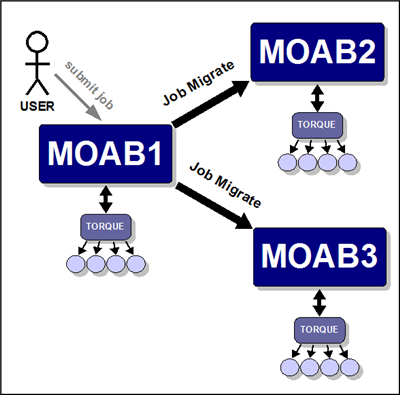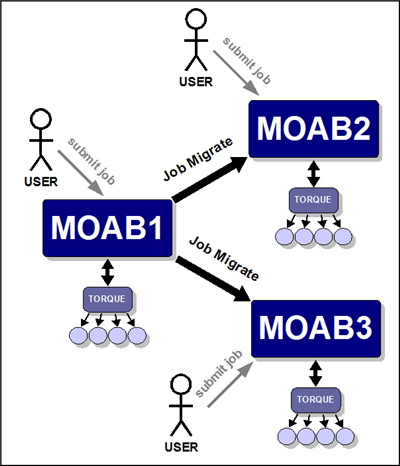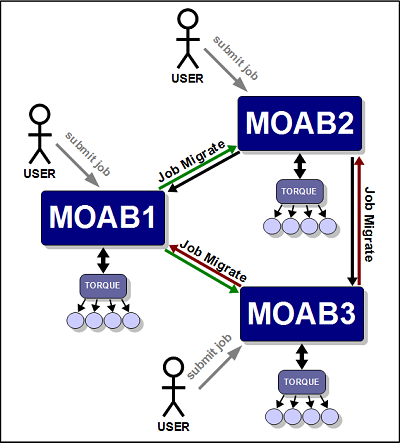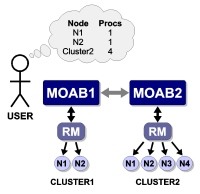17.1 Grid Basics
- 17.1.1 Grid Overview
- 17.1.2 Grid Benefits
- 17.1.3 Scalability
- 17.1.4 Resource Access
- 17.1.5 Load-Balancing
- 17.1.6 Single System Image (SSI)
- 17.1.7 High Availability
- 17.1.8 Grid Relationships
- 17.1.9 Submitting Jobs to the Grid
- 17.1.10 Viewing Jobs and Resources
17.1.1 Grid Overview
A grid enables you to exchange workload and resource status information and to distribute jobs and data among clusters in an established relationship. In addition, you can use resource reservations to mask reported resources, coordinate requests for consumable resources, and quality of service guarantees.
In a grid, some servers running Moab are a source for jobs (that is, where users, portals, and other systems submit jobs), while other servers running Moab are a destination for these jobs (that is, where the jobs execute). Thus, jobs originate from a source server and move to a destination server. For a source server to make an intelligent decision, though, resource availability information must flow from a destination server to that source server.
Because you can manage workload on both the source and destination side of a grid relationship, you have a high degree of control over exactly when, how, and where to execute workload.
17.1.2 Grid Benefits
Moab's peer-to-peer capabilities can be used for multiple purposes, including any of the following:
- manage access to external shared resources
- enable cluster monitoring information services
- enable massive-scalability clusters
- enable distributed grid computing
Of these, the most common use is the creation of grids to join multiple centrally managed, partially autonomous, or fully autonomous clusters. The purpose of this section is to highlight the most common uses of grid technology and provide references to sections which further detail their configuration and management. Other sections cover the standard aspects of grid creation including configuring peer relationships, enabling data staging, credential management, usage policies, and other factors.

17.1.3 Management-Scalability
Much like a massive-scalability cluster, a massive-scalability grid allows organizations to overcome scalability limitations in resource managers, networks, message passing libraries, security middleware, file systems, and other forms of software and hardware infrastructure. Moab does this by allowing a single large set of resources to be broken into multiple smaller, more manageable clusters, and then virtually re-assembling them using Moab. Moab becomes responsible for integrating the seams between the cluster and presenting a single-system image back to the end-users, administrators, and managers.
 |
Jobs cannot span clusters. |
17.1.4 Resource Access
In some cases, the primary motivation for creating a grid is to aggregate resources of different types into a single system. This aggregation allows for multi-step jobs to run a portion of the job on one architecture, and a portion on another.
A common example of a multi-architecture parameter-sweep job would be a batch regression test suite which requires a portion of the tests running on Redhat 7.2, a portion on SuSE 9.1, a portion on Myrinet nodes, and a portion on Infiniband nodes. While it would be very difficult to create and manage a single cluster which simultaneously provided all of these configurations, Moab can be used to create and manage a single grid which spans multiple clusters as needed.
17.1.5 Load-Balancing
While grids often have additional motivations, it is rare to have a grid created where increased total system utilization is not an objective. By aggregating the total pool of jobs requesting resources and increasing the pool of resources available to each job, Moab is able to improve overall system utilization, sometimes significantly. The biggest difficulty in managing multiple clusters is preventing inter-cluster policies and the cost of migration from overwhelming the benefits of decreased fragmentation losses. Even though remote resources may be available for immediate usage, migration costs can occur in the form of credential, job, or data staging and impose a noticeable loss in responsiveness on grid workload.
Moab provides tools to allow these costs to be monitored and managed and both cluster and grid level performance to be reported.
17.1.6 Single System Image (SSI)
Another common benefit of grids is the simplicity associated with a single system image based resource pool. This simplicity generally increases productivity for end-users, administrators, and managers.
An SSI environment tends to increase the efficiency of end-users by minimizing human errors associated with porting a request from a known system to a less known system. Additionally, the single point of access grid reduces human overhead associated with monitoring and managing workload within multiple independent systems.
For system administrators, a single system image can reduce overhead, training time, and diagnostic time associated with managing a cluster. Furthermore, with Moab's peer-to-peer technology, no additional software layer is required to enable the grid and no new tools must be learned. No additional layers mean no additional failure points, and that is good for everyone involved.
Managers benefit from SSI by being able to pursue organization mission objectives globally in a more coordinated and unified manner. They are also able to monitor progress toward those objectives and effectiveness of resources in general.
17.1.7 High Availability
A final benefit of grids is their ability to decrease the impact of failures. Grids add anothe rlayer of high avaialablity to the cluster-level high availability. For some organizations, this benefit is a primary motivation, pulling together additional resources to allow workload to continue to be processed even in the event that some nodes, or even an entire cluster, become unavailable. Whether the resource unavailability is based on node failures, network failures, systems middleware, systems maintenance, or other factors, a properly configured grid can reroute priority workload throughout the grid to execute on other compatible resources.
With grids, there are a number of important factors in high availability that should be considered:
- enabling highly available job submission/job management interfaces
- avoiding network failures with redundant routes to compute resources
- handling partial failures
- dynamically restarting failed jobs
17.1.8 Grid Relationships
There are three types of relationships you can implement within the grid:
17.1.8.1 Centralized Management (Master/Slave)
The centralized management model (master/slave) allows users to submit jobs to a centralized source server running Moab. The source Moab server obtains full resource information from all clusters and makes intelligent scheduling decisions across all clusters. Jobs (and data when configured to do so) are distributed to the remote clusters as needed. The centralized management model is recommended for intra-organization grid environments when cluster autonomy is not as necessary.
In the centralized management (master-slave) configuration, roles are clear. In other configurations, individual Moab servers may simultaneously act as sources to some clusters and destinations to others or as both a source and a destination to another cluster.
Example of the Centralized Management Model
XYZ Research has three clusters—MOAB1, MOAB2, and MOAB3—running Moab and the TORQUE resource manager. They would like to submit jobs at a single location (cluster MOAB1) and have the jobs run on whichever cluster can provide the best responsiveness.
The desired behavior is essentially a master-slave relationship. MOAB1 is the central, or master, cluster. On MOAB1, resource managers point to the local TORQUE resource manager and to the Moab servers on cluster MOAB2 and cluster MOAB3. The Moab servers on MOAB2 and MOAB3 are configured to trust cluster MOAB1 and to execute in slave mode.

With this configuration, XYZ Research may submit jobs to the master Moab server running on cluster MOAB1 and may, as stated earlier, submit jobs from the slave nodes as well. However, only the master Moab server may schedule jobs. For example, cluster MOAB2 and cluster MOAB3 cannot schedule a job, but they can accept a job and retain it in an idle state until the master directs it to run.
 |
You can turn off job submission on slave nodes by setting the DISABLESLAVEJOBSUBMIT parameter to TRUE. |
The master Moab server obtains full resource information from all three clusters and makes intelligent scheduling decisions and distributes jobs (and data when configured to do so) to the remote clusters. The Moab servers running on clusters MOAB2 and MOAB3 are destinations behaving like a local resource manager. The Moab server running on MOAB1 is a source, loading and using this resource information.
17.1.8.2 Source-Destination Management
As with the centralized management model (master/slave), the source-destination model allows users to submit jobs to a centralized source server running Moab. However, in the source-destination model, clusters retain sovereignty, allowing local job scheduling. Thus, if communication between the source and destination clusters is interrupted, the destination cluster(s) can still run jobs locally.

In the source-destination model, the source Moab server obtains full resource information from all clusters and makes intelligent scheduling decisions across all clusters. As needed, jobs and data are distributed to the remote clusters. Or, if preferred, a destination cluster may also serve as its own source; however, a destination cluster may not serve as a source to another destination cluster. The centralized management model is recommended for intra-organization grid environments when cluster autonomy is not as necessary.
17.1.8.3 Localized Management
The localized management (peer-to-peer) model allows you to submit jobs on one cluster and schedule the jobs on another cluster. For example, a job may be submitted on MOAB1 and run on MOAB3. Jobs can also migrate in the opposite direction (that is, from MOAB3 to MOAB1). The source servers running Moab obtain full resource information from all clusters and make intelligent scheduling decisions across all clusters. Jobs (and data when configured to do so) are migrated to other clusters as needed.

 |
Jobs will not migrate indefinitely. The localized management model limits them to one migration. |
This model allows clusters to retain their autonomy while still allowing jobs to run on any cluster. No central location for job submission is needed, and you do not need to submit jobs from different nodes based on resource needs. You can submit a job from any location and it is either migrated to nodes on the least utilized cluster or the cluster requested in the job submission. This model is recommended for grids in an inter-organization grid environment.
17.1.9 Submitting Jobs to the Grid
In any peer-to-peer or grid environment where jobs must be migrated between clusters, use the Moab msub command. Once a job has been submitted to Moab using msub, Moab identifies potential destinations and migrates the job to the destination cluster.
Using Moab's msub job submission command, jobs may be submitted using PBS or LSF command file syntax and be run on any cluster using any of the resource managers. For example, a PBS job script may be submitted using msub and depending on availability, Moab may translate a subset of the job's directives and execute it on an LSF cluster.
 |
Moab can only stage/migrate jobs between resource managers (in between clusters) that have been submitted using the msub command. If jobs are submitted directly to a low-level resource manager, such as PBS, Moab will still be able to schedule them but only on resources directly managed by the resource manager to which they were submitted. |
Example 1
A small pharmaceutical company, BioGen, runs two clusters in a centralized relationship. The slave is an older IBM cluster running Loadleveler, while the master manages the slave and also directly manages a large Linux cluster running TORQUE. A new user familiar with LSF has multiple LSF job scripts he would like to continue using. To enable this, the administrators make a symbolic link between the Moab msub client and the file bsub. The user begins submitting his jobs via bsub and, according to availability, the jobs run on either the Loadleveler or TORQUE clusters.
Example 2
A research lab wants to use spare cycles on its four clusters, each of which is running a local resource manager. In addition to providing better site-wide load balancing, the goal is to also provide some of its users with single point access to all compute resources. Various researchers have made it clear that this new multi-cluster load balancing must not impose any changes on users who are currently using these clusters by submitting jobs locally to each cluster.
In this example, the scheduler mode of the destination clusters should be set to NORMAL rather than SLAVE. In SLAVE mode, Moab makes no local decisions—it simply follows the directions of remote trusted peers. In NORMAL mode, each Moab is fully autonomous, scheduling all local workload and coordinating with remote peers when and how to schedule migrated jobs.
From the perspective of a local cluster user, no new behaviors are seen. Remote jobs are migrated in from time to time, but to the user each job looks as if it were locally submitted. The user continues to submit, view, and manage jobs as before, using existing local jobs scripts.
17.1.10 Viewing Jobs and Resources
By default, each destination Moab server will report all compute nodes it finds back to the source Moab server. These reported nodes appear within the source Moab as local nodes each within a partition associated with the resource manager reporting them. If a source resource manager was named slave1, all nodes reported by it would be associated with the slave1 partition. Users and administrators communicating with the source Moab via Moab Cluster Manager, Moab Access Portal, or standard Moab command line tools would be able to view and analyze all reported nodes.

 |
The grid view will be displayed if either the source or the destination server is configured with grid view. |
For job information, the default behavior is to only report to the source Moab information regarding jobs that originated at the source. If information about other jobs is desired, this can be configured as shown in the Workload Submission and Control section.



